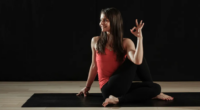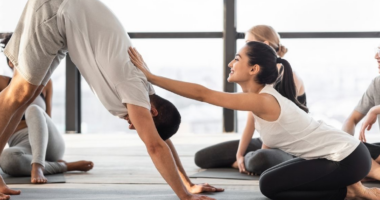Last week I was spending some time with my friends and we were talking about the importance of being able to understand the 5 movements of the spine in Yoga Asanas . When I was a kid, I loved to learn more about yoga and started doing Yoga Asanas with my friends in the neighborhood. Later, I started taking Yoga classes at one of the Yoga studios in my city. I had been doing yoga for almost 8 years and I knew that Yoga was very important in my life and I wanted to learn more about it.
We all know that Yoga is a great way to relax and calm your mind. What you might not know is that Yoga also helps build muscle strength, improves your flexibility, and helps you form a stronger core all while improving your overall health.
The spine is the foundation for all movement. It is the structural component of the human body that is responsible for the support and movement of our muscles, organs, and joints. When the spine is properly aligned, it provides a solid platform for the body to function. When the spine is imbalanced or not aligned, movement can be restricted and our body can experience pain and discomfort.
“If you want to be healthy, start with your spine.” -Socrates
One of the most essential components of the body is the spine. It gives you structure and support; without it, you wouldn’t be able to stand, much less stay upright.
Yoga is a deliberate activity that decompresses the spine and creates a sense of spaciousness. Yoga may also assist with pain from herniated discs, scoliosis, and general low-back discomfort in certain instances. Sign up for this free 30-day yoga challenge if you want to work deeper into and around your spine. You’ll be led through the postures so that when you’re ready to practice on your own, you’ll be ready.
Let’s look at the five distinct spine motions in yoga asana practice, and how to safely and efficiently practice and traverse them.
Please note that if you have a spine problem, you should practice with a professional yoga instructor one-on-one. If in doubt, get medical advice before doing any of these exercises.
1. Extension of the Axis

The action of axial extension lengthens and straightens the spine along its axis. It decompresses the spine and allows for more lung expansion. To put it another way, it creates room in the spine without moving it in any direction except upwards.
Stand in Tadasana to learn about axial extension. Draw upward through the top of your head and the sternum on each inhale, and picture yourself breathing room between each vertebra. Downward Dog, High Plank, Crescent Lunge, and, in general, any posture with a long and neutral spine will feel this movement.
Axial extension is essential to learn and use in active spinal motions because it helps to relieve any harmful compression that may occur.
Tadasana (Mountain pose), Adho Mukha Svanasana (Downward Dog), Dandasana, and Navasana are all examples of axial extension in yoga.
2. Flexibility

Flexion is a movement that extends the posterior chain by bringing the spine down and forward towards the legs. Forward bends are also known as spinal flexion in yoga practice. Cat position and Child’s pose are two postures in which the spine is largely rounded and in flexion. It’s reasonable to state that, depending on the flexibility of the back body, the spine may be somewhat rounded when in passive flexion.
It’s essential to generate length (think axial extension) before folding deeper in active forward bends like Uttanasana or Paschimottanasana.
To further comprehend spinal flexion, consider Paschimottanasana (sitting forward fold). Take a seat in Staff pose/Dandasana and raise your arms above with an inhalation, stretching your spine upwards. Begin to hinge forward from the hips, drawing back through the sitting bones and pushing the navel in towards the spinal column. Consider extending forward with your sternum to the tops of your feet. As the spine folds forward, engaging the leg muscles may also assist to lengthen it.
When the back of the body is tight, actively folding forward may cause tightness in the lower back. Bend the knees and anteriorly tilt the pelvis to preserve optimum length, as though you want to accentuate the lumbar curvature.
Balasana (Child’s posture), Uttanasana (Standing Forward Bend), and Prasarita Padottanasana are all examples of spinal flexion in yoga.
3. Prolongation

A movement that lengthens the spine vertically (axial extension) and rearward is known as spinal extension. Spinal extension, often known as backward bends (or just backbends) in yoga, extends and strengthens the spine, especially the thoracic spine and the chest and shoulder muscles.
Bending backwards from the lower spine is one of the most frequent backbend misalignments, producing compression that may cause lower back discomfort in healthy people or aggravate an existing lower back problem. As a result, it’s critical to build length before starting the spinal extension action.
Consider a basic backward bend from a standing position. Begin in Tadasana and raise your arms above while lengthening your spine upwards as you inhale. As you bend from the upper back, open the chest to the sky, pull the navel in and start to bring the inner shoulder blades towards the middle of the spine, keeping length in the lower back.
If you’re used to bending from your lower back, you may not feel as “deep” in the backbend, but muscle integrity allows you to do the exercise in a supported and safe way. Consider pulling the belly button in and extending the tailbone down while in alternating backbends to preserve lumbar spine length.
Urdhva Hastasana (Upward Salute), Ustrasana (Camel position), Setu Bandhasana, and Urdhva Dhanurasana (Upward Bow/Wheel posture) are all examples of spinal extension in yoga.
4. Lateral Flexion Is a Kind of Flexion in Which the Body Bends

Lateral flexion is a movement in which the body bends to one side or the other. It opens up the side body, strengthens the obliques, and aids with spine flexibility. Lateral flexion also helps to open up the ribcage, which aids in lung expansion and deeper breathing.
Moving into lateral flexion, like spinal flexion and extension, has the ability to compress the lower back. Before bending the body to the side, it is critical to generate length (axial extension).
Consider the crescent posture when standing. With the exception of the first two fingers, stand tall in tadasana with arms above. Reach up through the tips of your index fingers on an inhale and bend to the right on an exhale. Use each successive inhale to expand your space, and each subsequent exhale to fold your body farther to the side. To maintain the lower back long and protected, pull in through the navel.
Standing Crescent posture, Parighasana (Gate pose), and Parivrtta Janu Sirsasana are all examples of lateral flexion in yoga (Revolved Head-to-Knee pose).
5. Axial Rotation

Axial rotation is a movement in which the spine rotates or twists. It’s a yoga technique for lubricating the spine and increasing its range of motion. Spinal twists are an excellent method to warm up the spine before flexion or extension, and they may also assist to neutralize the spine after flexion or extension.
Before twisting, establish length in the spine like you did with the preceding motions. As an example, consider Ardha Matsyendrasana. Reach the right arm above and extend the spine as you inhale, keeping both sitting bones and the left hand firmly planted on the floor. Exhale and rotate your spine to the left, your right elbow on the outside of your left thigh. Exhale-twist, pause, and inhale again for additional length. Pull in through the navel. Take a deep breath before each extra twist to generate space and length.
When twisting, keep in mind that you’re rotating the whole length of your spine, not just the neck, which may take up the bulk of the rotation.
Parivrtta Utkatasana (Revolved Chair position), Parivrtta Trikonasana (Revolved Triangle), Ardha Matsyendrasana (Half Lord of the Fishes), and Bharadvajasana are all examples of axial rotation in yoga.
The lower back, as we know, is a sensitive region that is prone to tension from spinal motions. Compression is reduced when any of the spinal motions are started with axial extension (length), especially in the lower back.
Understanding the various spinal motions as they relate to yoga practice is critical to maintaining a safe and successful practice. This short tutorial can perhaps assist you in navigating spinal mobility in your yoga practice.
In this video, the spine is described as being in 5 different movements, which are explained below:. Read more about the spine is laterally twisted in which asana and let us know what you think.
Frequently Asked Questions
What are the 5 movements of the spine?
The 5 movements of the spine are flexion, extension, lateral bending, rotation, and circumduction.
What are the movements of the spine?
The movements of the spine are called flexion and extension. Flexion is when you bend your back, while extension is when you straighten your back.
What are the 6 movements of the spine?
The 6 movements of the spine are flexion, extension, lateral flexion, rotation, circumduction and axial rotation.

